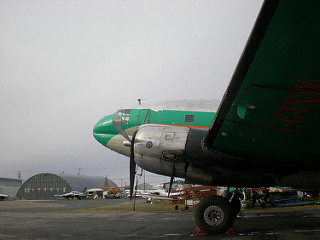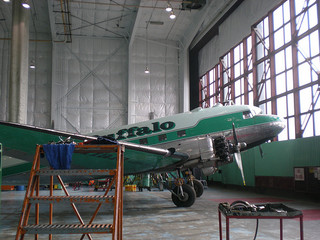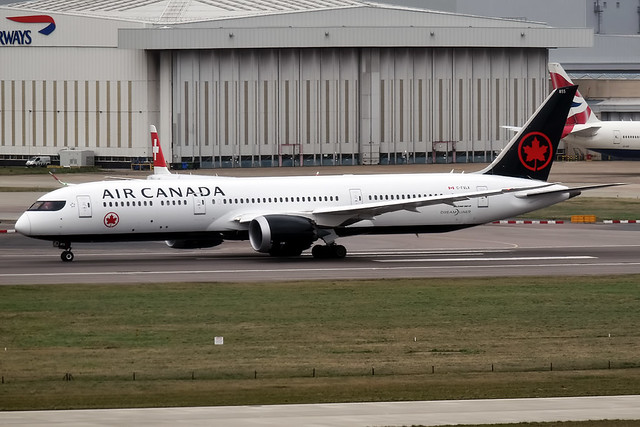Buffalo DC3 at Yellowknife on Aug 19th 2013, engine fire
Last Update: April 27, 2015 / 22:08:06 GMT/Zulu time
Incident Facts
Date of incident
Aug 19, 2013
Classification
Accident
Cause
Engine fire
Airline
Buffalo Airways
Flight number
J4-168
Departure
Yellowknife, Canada
Destination
Hay River, Canada
Aircraft Registration
C-GWIR
Aircraft Type
DOUGLAS DC-3
ICAO Type Designator
DC3
Airport
Yellowknife Airport, Yellowknife
Airport ICAO Code
CYZF
The Canadian TSB have opened an investigation into the accident.
Ground observers reported the aircraft did not extend the gear on final approach and landed on its belly coming to a stop about 100 meters short of the runway in a ditch.
Passengers reported the right hand engine was on fire, the aircraft clipped the tops of a number of trees before the crew was able to steer the aircraft onto an open field for a hard touch down. All occupants are safe.
NAV Canada reported later that the aircraft departed runway 16, during climb out tower observed torching and smoke from the right hand engine and notified the crew, but received no reply. Tower cleared the aircraft to land on runway 10 and advised emergency services, the aircraft circled for an approach to runway 10, on final approach tower notified the crew the gear was not down, the aircraft crash landed on the south west in field south of the threshold runway 10. The airport was closed for about 45 minutes until runway 16/34 was made available again.
On Aug 28th 2013 the Canadian TSB reported that shortly after takeoff from runway 16 the crew observed a fire in the right hand engine (PW R-1830-92), shut the engine down and performed a low altitude turn towards runway 10. The aircraft struck a stand of trees south west of the threshold runway 10 and landed with the gear up south of the runway, no post impact fire occurred, the aircraft was evacuated. No injuries occurred to the 21 passengers and 3 crew.
On Apr 27th 2015 the Canadian TSB released their final report concluding the probably causes of the accident were:
Findings as to causes and contributing factors
- An accurate take-off weight and balance calculation was not completed prior to departure, resulting in an aircraft weight that exceeded its maximum certified take-off weight.
- The right engine number 1 cylinder failed during the take-off sequence due to a pre-existing fatigue crack, resulting in an engine fire.
- After the right propeller’s feathering mechanism was activated, the propeller never achieved a fully feathered condition likely due to a seized bearing in the feathering pump.
- The windmilling right propeller caused an increase in drag which, combined with the overweight condition, contributed to the aircraft’s inability to maintain altitude, and the aircraft collided with terrain short of the runway.
- The operator’s safety management system was ineffective at identifying and correcting unsafe operating practices.
- Transport Canada’s surveillance activities did not identify the operator’s unsafe operating practices related to weight and balance and net take-off flight path calculations. Consequently, these unsafe practices persisted.
Findings as to risk
- If companies do not adhere to operational procedures in their operations manual, there is a risk that the safety of flight cannot be assured.
- If Transport Canada does not adopt a balanced approach that combines inspections for compliance with audits of safety management processes, unsafe operating practices may not be identified, thereby increasing the risk of accidents.
- If cockpit or data recordings are not available to an investigation, this may preclude the identification and communication of safety deficiencies to advance transportation safety.
Other findings
- Current Canadian Aviation Regulations permit a transport category piston-powered aircraft to carry passengers without a flight data recorder or cockpit voice recorder.
The TSB reported that the airline has a walk-in/on demand scheme that permits passengers to show up for boarding without pre-booking a seat. If the passenger count exceeds the capacity of the aircraft a stand by aircraft is being dispatched, on Aug 19th 2013 a stand by aircraft needed to be dispatched.
The accident aircraft was loaded with cargo and 17 passengers, the passengers and their luggage were not weighed at check in. After the aircraft had been loaded, 4 last minute passengers boarded the aircraft along with the luggage.
At the time of departure the operational flight plan had been partially completed without passenger count, cargo weight, the crew never received a cargo manifest.
The aircraft subsequently departed Yellowknife's runway 16 from intersection runway 16/34 with runway 10/28 with a takeoff distance available of 5956 feet.
About 2 minutes after the takeoff clearance was issued tower observed heavy torching and smoke from the right hand engine and called the aircraft reporting the observation but did not receive a reply. The crew was just retracting the landing gear when they observed fire in the right hand engine and initiated the checklist which included to shut the engine down and feather the propeller.
The right propeller moved towards the feathered position but did not reach the feathered position and continued windmilling.
The crew initiated a low altitude, the aircraft reached a maximum height of 180 feet AGL, right hand turn in an attempt to reach runway 10 but struck a stand of trees, about 30 feet in height, about 690 feet southwest of the threshold of runway 10 and impacted ground about 400 feet past the trees. The wreckage trail extended over 330 feet parallel to and south of runway 10.
Landing gear and flaps were found in the retracted position, the ELT did not activate due to the relatively low impact energy.
After the aircraft came to a stand still the flight attendant initiated the evacuation of the aircraft, all 21 passengers exited the aircraft through the left aft door. The flight attendant then returned to the aircraft and moved some galley drawers that were blocking the cockpit door and confirmed the flight crew was safe, all three crew then evacuated the aircraft.
Arriving emergency services, who had been near the threshold of runway 10 due to an unrelated vehicle recovery operation, foamed the aircraft as a precaution.
The TSB reported that the aircraft was not equipped with a flight data recorder or a cockpit voice recorder and was not required to carry those items by Canadian regulations.
The TSB reported that the aircraft is certified for a maximum takeoff weight (MTOW) of 26,200 lbs. The aircraft carried 2707lbs of fuel, 21 passengers along with their cargo and 3 crew, which using standard weights resulted in an estimated takeoff weight of 27,435 lbs, 1235 lbs above MTOW. The TSB cited a study by the Australian TSB who had experimentally determined the aircraft with the left hand (critical) engine shut down and the propeller windmilling would be able to climb at 100fpm at 26,200 lbs, maintain altitude at 28,000 lbs and descend at 90 fpm at 30,000 lbs.
The TSB reported that the right hand engine's #1 cylinder's head and barrel were found separated due to a fracture of the barrel along the threaded joint with the head. A pre-existing fatigue crack was discovered in a thread groove, the cause of the crack could not be determined due to the accident impact damage.
The feathering system of the right hand propeller was designed to move the propeller to 88 degrees of pitch which stops the rotation of the propeller and thus reaches minimum drag. An oil pump driven by an electrical motor supplies oil pressure to the propeller dome which moves the propeller into its feathered position, when the propeller reaches the full stop position the pressure would increase to 600psi at which point the the cut out switch prompts the motor to de-energize. If the pressure of 600psi is not reached the motor and pump continue to operate until they fail. The feathering system is also design to unfeather the propeller. If the feathering system continues to run beyond the feather position, the propeller would move through the feathered position and reach fine pitch again. Douglas had issued a flight operations bulletin following an accident in the Netherlands advising crews that it was possible to interrupt the feathering manually in case the cut off switch did not operate, the accident crew was aware of this bulletin. In the post accident examination During the propeller was found at a blade angle of 46 degrees only which reduced but did not stop the windmilling.
The TSB analysed: "Feathering the propeller of an inoperative engine is critical to the performance of a multi-engine aircraft as it reduces parasite drag by moving the propeller blades towards a coarser pitch angle relative to the flight path of the aircraft. In most cases, the propeller will stop spinning. A non-feathered, or windmilling, propeller will induce a high parasite drag penalty on aircraft performance. In order to maintain airspeed at or above the minimum airspeed of 90 knots indicated airspeed (KIAS), Buffalo 168 (BFL168) sacrificed climb performance and was barely able to maintain a constant altitude. Manoeuvring the aircraft to return to the airport led to a loss of altitude, which ultimately resulted in the collision with terrain. After the right propeller’s feathering mechanism was activated, the propeller never achieved a fully feathered condition due to a system failure. Post-occurrence testing of the propeller feathering system indicated the oil pump motor failed likely due to a seized bearing. Activation of the feathering system results in the pump motor running until sufficient oil pressure develops to trip the pressure-sensitive cut-out switch, set for 600 pounds per square inch (psi), which occurs when full feather position is reached. The compromised bearing likely slowed the motor speed resulting in decreased oil pressure. The pump will continue to run until it fails if the trip pressure is not reached and system operation is not monitored. There is no back-up pump."
The TSB analysed: "Aircraft performance, as indicated in the aircraft flight manual (AFM), is predicated on the weight of the aircraft. In this occurrence, a complete and accurate weight and balance report was not calculated prior to takeoff. As the aircraft’s weight and balance had not been updated since 1990, using actual passenger and cargo weights may not have produced an accurate take-off weight. As such, the crew would not be able to determine accurately the aircraft’s performance capabilities during a normal takeoff. As was determined in the 1994 Australian DC-3 accident report19, aircraft operating above the maximum certified take-off weight (MCTOW) experience a serious degradation in climb performance when experiencing an engine failure with a windmilling propeller."
The TSB thundered:
In this occurrence, the aircraft departed without a completed weight and balance calculation and was later determined to weigh in excess of the MCTOW at the time of departure. The investigation found that it was common to operate in this manner, and that weight and balance forms were normally completed enroute without the benefit of accurate information and without using standard or actual passenger weights as required by the Company Operations Manual (COM). The risks associated with operating the aircraft overweight may not have been fully appreciated by the crews since net take-off performance calculations required by the Canadian Aviation Regulations (CARs) and specified in the COM were not being conducted. As a result, no assessment of obstacle clearance in the event of an engine failure during takeoff had been carried out. Successful adaptations from procedures tend to reinforce that activity. Therefore, previous success in operating the aircraft overweight was likely taken as assurance of future performance without consideration being given to aircraft performance in the event of an emergency. Given that neither the Pro-Active nor the Re-Active Risk Assessment programs identified issues relating to operational control, weight and balance or calculated aircraft performance, and that the practice of adjusting weight and balance calculations to maintain them within limits after departure was well known and accepted by senior management, it was highly unlikely that these unsafe practices would be reported through, or addressed by, the company’s SMS.
There were other indications that the organizational culture at Buffalo Airways was not supportive of a system that required the organization to take a proactive role in identifying hazards and reducing risks. The company’s response to deficiencies identified during TC surveillance activities demonstrated an adversarial relationship between the company and the regulator. The company refuted the regulatory basis of findings, questioned the competence of TC inspectors and initially did not take responsibility for the issues identified. The overall picture that emerged from this investigation is of an organization that met the basic requirements of regulations and then only when pushed by the regulator. An SMS introduced into a culture motivated merely to comply with regulations is unlikely to be effective. The operator’s SMS was ineffective at identifying and correcting unsafe operating practices.
With respect to the regulator, Transport Canada, the TSB analysed: "The current approach to regulatory oversight, which focuses on an operator’s SMS processes almost to the exclusion of verifying compliance with the regulations, is at risk of failing to address unsafe practices and conditions. If TC does not adopt a balanced approach that combines inspections for compliance with audits of safety management processes, unsafe operating practices may not be identified, thereby increasing the risk of accidents."
Metars:
CYZF 200100Z 16003KT 15SM VCSH FEW010 BKN040CB BKN140 BKN240 18/14 A2930 RMK SC1CB5AC2CI1 SC TR CI TR SLP926 DENSITY ALT 1800FT=
CYZF 200000Z 20003KT 15SM VCSH FEW010 SCT040CB BKN150 BKN240 18/14 A2929 RMK SC1CB4AC2CI1 SC TR SLP925 DENSITY ALT 1800FT=
CYZF 192325Z 25005KT 15SM VCSH FEW010 SCT040CB BKN150 OVC240 18/13 A2928 RMK SC1CB3AC2CI2 SLP922 DENSITY ALT 1800FT=
CYZF 192300Z 23005KT 15SM VCSH FEW010 SCT040CB BKN150 BKN240 17/13 A2928 RMK SC1CB3AC2CI2 SC TR SLP920 DENSITY ALT 1800FT=
CYZF 192200Z 23009KT 15SM VCSH FEW007 BKN030TCU BKN140 BKN240 20/14 A2928 RMK SF1TCU4AC1CI1 SLP918 DENSITY ALT 2100FT=
CYZF 192100Z 22007KT 15SM FEW009 SCT040TCU BKN140 BKN240 18/15 A2928 RMK SF2TCU2AC1CI2 SLP920 DENSITY ALT 1900FT=
Related NOTAM:
B3842/13 - RWY 10/28 CLSD AVBL AS TWY. 20 AUG 17:15 2013 UNTIL 20 AUG 20:00 2013. CREATED: 20 AUG 17:23 2013
Aircraft Registration Data
Aircraft registration data reproduced and distributed with the permission of the Government of Canada.
Incident Facts
Date of incident
Aug 19, 2013
Classification
Accident
Cause
Engine fire
Airline
Buffalo Airways
Flight number
J4-168
Departure
Yellowknife, Canada
Destination
Hay River, Canada
Aircraft Registration
C-GWIR
Aircraft Type
DOUGLAS DC-3
ICAO Type Designator
DC3
Airport
Yellowknife Airport, Yellowknife
Airport ICAO Code
CYZF
This article is published under license from Avherald.com. © of text by Avherald.com.
Article source
You can read 2 more free articles without a subscription.
Subscribe now and continue reading without any limits!
Read unlimited articles and receive our daily update briefing. Gain better insights into what is happening in commercial aviation safety.
Send tip
Support AeroInside by sending a small tip amount.
Related articles
Buffalo B732 at Goose Lake and Yellowknife on Oct 20th 2025, uncommanded nose gear extension and collapse
A Buffalo Airways Boeing 737-200, registration C-GTVO performing flight J0-202 from Goose Lake,NU to Yellowknife,NT (Canada) with 3 crew on board,…
Buffalo DC3 near Hay River on May 3rd 2019, forced landing after engine failure
A Buffalo Airways Douglas C-47A Skytrain (DC-3), registration C-GJKM performing flight J4-169 from Hay River,NT to Yellowknife,NT (Canada) with 2…
Buffalo C46 near Deline on Sep 25th 2015, engine oil leak, prop did not feather, intentional gear up landing and runway overskid
A Buffalo Airways Curtiss C-46A-45CU, registration C-GTXW performing flight J4-525 from Yellowknife,NT to Norman Wells,NT (Canada) with 3 people on…
Buffalo DC3 at Hay River on Dec 17th 2014, smoking engine
A Buffalo Airways Douglas DC-3, registration C-GWZS performing flight J4-169 from Hay River,NT to Yellowknife,NT (Canada) with 16 passengers and 3…
Newest articles
EAT Leipzig A306 at Brussels on Nov 26th 2020, rejected takeoff above V1 due to difficulties becoming airborne
An EAT Leipzig Airbus A300-600 freighter on behalf of DHL, registration D-AEAI performing flight QY-841 from Brussels (Belgium) to Vitoria,SP…
Canada B789 at Auckland on Jan 13th 2026, unusual odour
An Air Canada Boeing 787-9, registration C-FVLX performing flight AC-40 from Auckland (New Zealand) to Vancouver,BC (Canada) with 269 passengers and…
Subscribe today
Are you researching aviation incidents? Get access to AeroInside Insights, unlimited read access and receive the daily newsletter.
Pick your plan and subscribePartner

ELITE Simulation Solutions is a leading global provider of Flight Simulation Training Devices, IFR training software as well as flight controls and related services. Find out more.
SafetyScan Pro provides streamlined access to thousands of aviation accident reports. Tailored for your safety management efforts. Book your demo today
AeroInside Blog
Popular aircraft
Airbus A320Boeing 737-800
Boeing 737-800 MAX
Popular airlines
American AirlinesUnited
Delta
Air Canada
Lufthansa
British Airways




